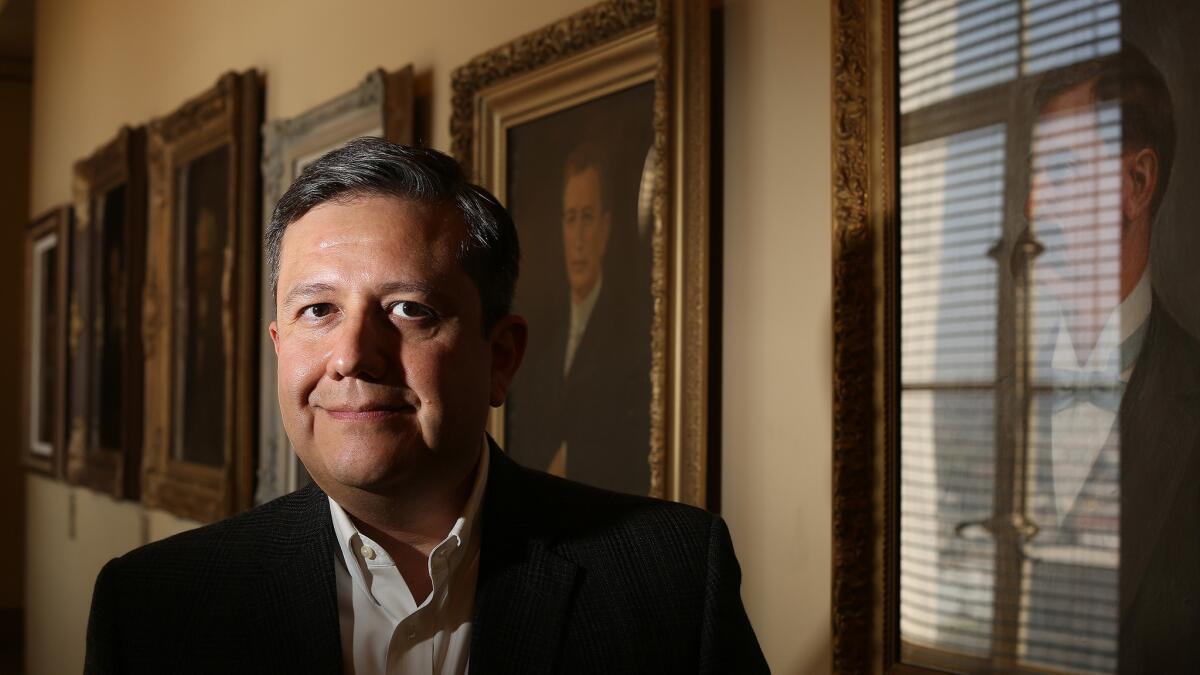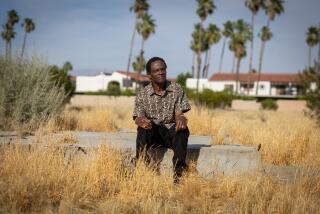‘An end to all the excuses,’ says L.A.’s chief bureaucrat in push for $1.8-billion homelessness plan

While guiding Los Angeles on its painful budget recovery, City Administrative Officer Miguel Santana often had to be the naysayer.
He told the city no to hiring, he told the unions no to raises and he told the voters no to fixing sidewalks and streets without new taxes.
But when it comes to the city’s homeless crisis, Santana has a vision he believes the city can’t say no to.
Stepping out of the CAO’s traditional posture of neutral bureaucrat, Santana has become a prominent voice for new taxes to support his $1.8-billion homelessness plan.
I think it’s time when we say an end to all the excuses. This is the time where we all must take responsibility.
— L.A. City Administrative Officer Miguel Santana, on efforts to end homelessness
“I think it’s time when we say an end to all the excuses,” he said in a speech last month. “This is the time where we all must take responsibility.”
From his college days as a shelter volunteer through his oversight of L.A. County’s Project 50 to identify and house skid row’s most vulnerable residents, Santana has nurtured a sensitivity to the homeless that is now on full display.
“It’s time that we move forward in a very aggressive way,” he told an audience of donors during the speech last month as he accepted an honor from the homeless services group Shelter Partnership.
That kind of rhetoric is not endemic to the office created in 1951 to independently advise the mayor and City Council on the budget, labor negotiations and policy.
Even though the job is nonpolitical, “there is room for the CAO to have a voice,” said Raphael Sonenshein, executive director of the Pat Brown Institute at Cal State Los Angeles. But “you don’t want to be a CAO who overshadows the mayor or council or goes against their interest.”
When appearing in public, often at the side of the city’s elected officials, Santana does nothing overtly to overshadow. His lightly inflected — almost delicate — speech is the model of bureaucratic reserve.
It’s the words themselves that pop.
At a homeless summit this spring, he invoked the late Mayor Tom Bradley’s grand transportation vision as his model.
“He insisted on moving it forward,” Santana said. “He brought in support … to a point where a convincing case was made that all Angelenos should invest in it, and we have.”
Some City Hall watchers suggest Santana is nudging Mayor Eric Garcetti to be more aggressive on the issue.
“He just happens to be working in the administration of a mayor who takes a great deal of care before he steps out on anything,” said longtime Democratic strategist Darry Sragow. “In this situation clearly Miguel feels that the city needs to take major steps and so he’s going to wind up being an advocate and a prod.”
“He nudges us all,” said Councilman Marqueece Harris-Dawson, chairman of the council’s Homelessness and Poverty Committee.
Where politicians can be overwhelmed by a problem that seems limitless, Harris-Dawson said, Santana has broken it down into concrete steps: a 47-point comprehensive plan, a price tag of $1.8 billion and a list of potential new taxes to pay for it.
The City Council on Wednesday agreed to press forward with a large portion of that plan, voting unanimously to place a $1.2-billion property tax hike on the November ballot. The council is leaving open the possibility of pursuing an alternate $900-million property tax increase, which will be up for discussion Friday.
In an interview, Santana characterized his stance as a confluence of his professional trajectory with his personal narrative.
His encounter was at Whittier College in the late 1980s.
“As a college student I worked four years, first as a volunteer at a homeless shelter and eventually running the shelter myself,” he said.
“I’d spend many nights opening up the local hall at a church or a synagogue, helping homeless people, putting out cots, staying overnight with them, dealing with the occasional hostile situation, then closing up,” Santana said.
As rewarding as the work was, he saw that it had no permanent effects.
“We weren’t helping end homelessness,” he said. “We were keeping them alive during the coldest time of the year. That’s an important thing to do, but that doesn’t end homelessness and results in seeing the same people year after year.”
Years later, as deputy chief executive officer overseeing all social services for Los Angeles County, Santana was engaged in Project 50, a pilot program that identified the most vulnerable skid row inhabitants and offered immediate housing backed by intense social services.
At the height of the Great Recession, Santana failed to persuade the Board of Supervisors to expand Project 50 into Project 500, but today Santana credits one of its clients, whom he called only Mr. Livingstone, with enlightening him.
“It took an entire team working with Mr. Livingstone at the pace that he needed with the very deliberate persistent and compassionate approach of very talented case workers to convince him to move into housing,” Santana said.
“It was through that that I learned and the bureaucracy learned that homelessness is an issue you solve one person at a time.”
Appointed by Mayor Antonio Villaraigosa in 2009 as the city’s chief bureaucrat, Santana had little chance to act upon that principle. His first five years as city administrative officer were dominated by the budget crisis.
Though famously soft-spoken, Santana proved steely in standing up for severe budget trims and demanding new taxes for service improvements.
Cheryl Parisi, head of the Coalition of L.A. City Unions, declined to comment on his homeless proposals.
But after he recommended that the city shed 4,000 employees during the Villaraigosa administration, labor groups tried to get incoming Mayor Garcetti to dump him.
He survived that crisis and an earlier one in 2010 when a drunk driving conviction threatened his career.
Since then he’s practiced sobriety, he said. The experience further shaped his personal connection to the homeless people around him.
At this point in his life, they are literally at his doorstep.
After raising four daughters in Claremont, Santana, who is now divorced, lives in an apartment beside Pershing Square and embraces the downtown, walk-to-work lifestyle.
But an adult daughter who lives with him told him she was uncomfortable on the walk to the nearby Whole Foods.
She sometimes asks, “‘Can we drive because I’m embarrassed to walk with groceries in front of homeless people?’” Santana said in the interview.
It’s an image that captures everything that drives him.
“A lot of people wonder why the city’s top bureaucrat would care about this issue,” he told the 375 supporters of Shelter Partnership at the Biltmore Hotel dinner. ”I care about it not because I managed to have this as a part of my life for my entire adult life, but also it makes sense. It makes financial sense. It makes sense for the entire city.”
After receiving his award, as guests queued up to leave the parking lot, Santana walked home on streets that were deserted except for the shadowy shapes of sleeping homeless people.
Twitter: @LATDoug
More to Read
Sign up for Essential California
The most important California stories and recommendations in your inbox every morning.
You may occasionally receive promotional content from the Los Angeles Times.











